| The Mission
Creek Restoration Project is an opportunity to look at the
dynamics of a creek. As you walk down the trail you can
envision how Fremont looked when early settlers came to this
area. The plants provided food for many of the inhabitants of
the region, while the critters in the creek provided food for
larger animal. As humans, we need to appreciate and
understand how streams work and why it is important to keep
our waterways clean and flowing. |
Recommended Grades: Primary to
Secondary
Subjects:
Physical Education, Social Studies, Science, Art
Background:
Fremont has been slowing metamorphosing from an agricultural area to
suburban to urban center. Some of the children living in Fremont
are unfamiliar with ecological principals or the joys of natural
environments. Past generations of children used the creeks as their
playground, now many children don’t even realize we have creeks in
Fremont.
The Mission Creek
Trail between Palm Ave and Driscoll can act as a vehicle that can
enforce many cross curriculum principles.
Activities:
Primary:
Science: Mission Creek has abundant insects, worms, and many creepy
crawlies. All grades can visit the area and see critters and
plants. Just to visit and see the difference between spring and
winter is information that will stay with a child forever.
Students can love science if they realize that observing and record
information in a place like Mission Creek is science.
Literature:
Students can learn many terms just by observing a creek.
Students can find words that help them describe what they see. Math
terms also help them descript especially geometry. For example, how
many leaves are on a branch and how are they arranged. This helps
build students descriptive language.
Social Studies:
Mission Creek was a valuable waterway not only for the Ohlone
Indians but the early settlers. It provided the needed water that
was essential to live.
Physical
Education:
Walking and appreciating nature can be a lifelong hobby. It is an
excellent way to keep healthy.
Secondary:
Science:
Mission Creek is an outdoor lab to collect data. Students can use
the area to observe water flow patterns as well as changing of wind
patterns. The microorganisms that live in the creek acts as a real
look at nature under the microscope, not just a store purchased
slide.
Literature:
Students can use the creek to learn how to use nature as a metaphor
to life. Many words that we use to describe our road through live
can be used as a comparison to nature. For example, a troubled youth
meanders his life from one decision to another.
Physical
Education:
Students can use the trail to run or just to walk along. Students
should also be aware that when they make short cuts through the
vegetation, they might be disrupting a habitat.
| The guided tour
information below takes you from Palm Ave toward Driscoll
Road, the area restored in 2003. |
Mission Creek Watershed
Water starts flowing from springs at Mt. Alison,
near Mission Peak. The creek flows along Mill Creek Road and
passes by the Mission San Jose. Vargas Creek joins Mission Creek
under the 680 Freeway. It continues to flow downhill toward Lake
Elizabeth where it is joined by Morrison Creek. Mission Creek
continues to flow alongside Lake Elizabeth, bringing nutrients and
water to Stivers Lagoon. Mission Creek divides under Paseo
Padre into Laguna Creek and Irvington Creek.
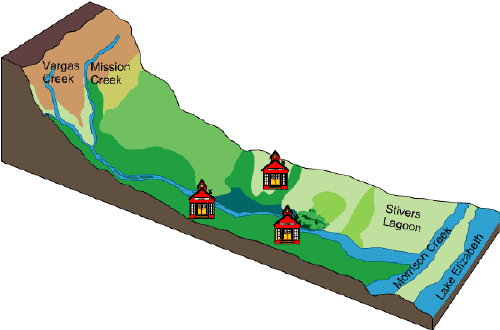
Elements of Mission Creek Stream Corridor
Many forces create Mission Creek’s stream channel
over time. The abundance of water (surface or ground), type of rock,
soil composition, biological growth, and tectonic forces are all at
work. Creekside vegetation is referred to as the "riparian zone."
It helps protect the stream channel while providing habitat for
organisms who use the creek.

Pools and Riffles
A
stream can be a challenge for organisms that live in water. Flowing
water can move mud, sand, and gravel. The faster the water flows
the larger the particles it can move. As the water slows, particles
will settle out and be deposited. High velocity can scour areas
that create pools, which support plankton (floating organisms), and
larger animals like frogs and fish. Riffles, or areas of gravel
help provide dissolved oxygen as the water mixes with the
atmosphere. Organisms require dissolved oxygen to live.
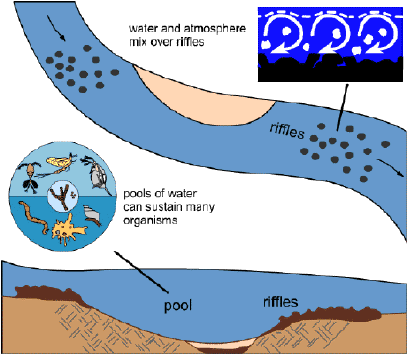
Erosion, A Natural Part of Creek Evolution
A stream channel is created and maintained by its
energy flow. The erosion in Mission Creek is the result of
topography, rock type, soil cover, climate, ground water, and
vegetation. Erosion of the stream bed increases when velocity of the
flow increases. Soil and rock particles are detached when energy is
highest. In low energy areas particles will be deposited. A stream
is always changing.
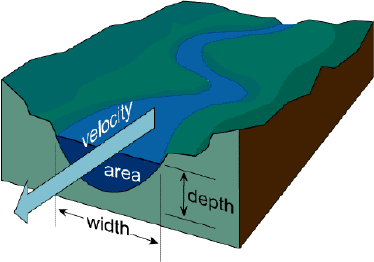
Tree Canopy Provides Healthy Conditions
Trees create many habitats for different organisms throughout the
stream corridor. Shade protects aquatic organisms by helping to
lower the water temperature during the summer In the winter the
canopy provides protection from the effect of storms. Tree roots
assist in reducing erosion within the floodplain.
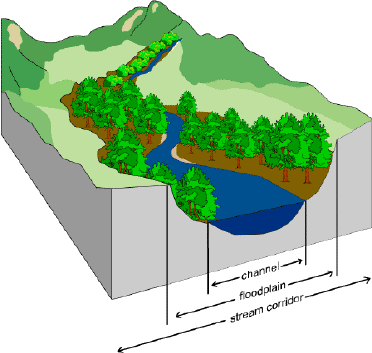
Biological Bonanza Downstream
Dissolved nutrients from the upper reaches of Mission Creek, flow
downstream until it finds a topographically level area. Mission
Creek and its tributary, Morrison Creek feed into Stivers Lagoon
alongside Lake Elizabeth. Stivers Lagoon is a fresh water marsh,
providing habitat for local flora and fauna.
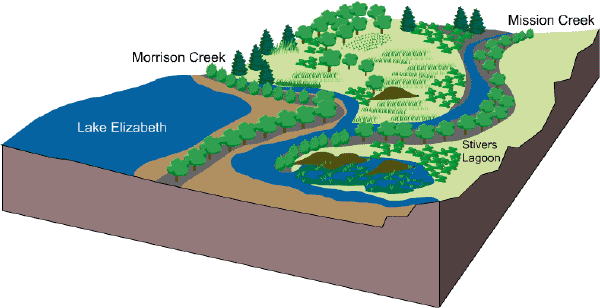 |